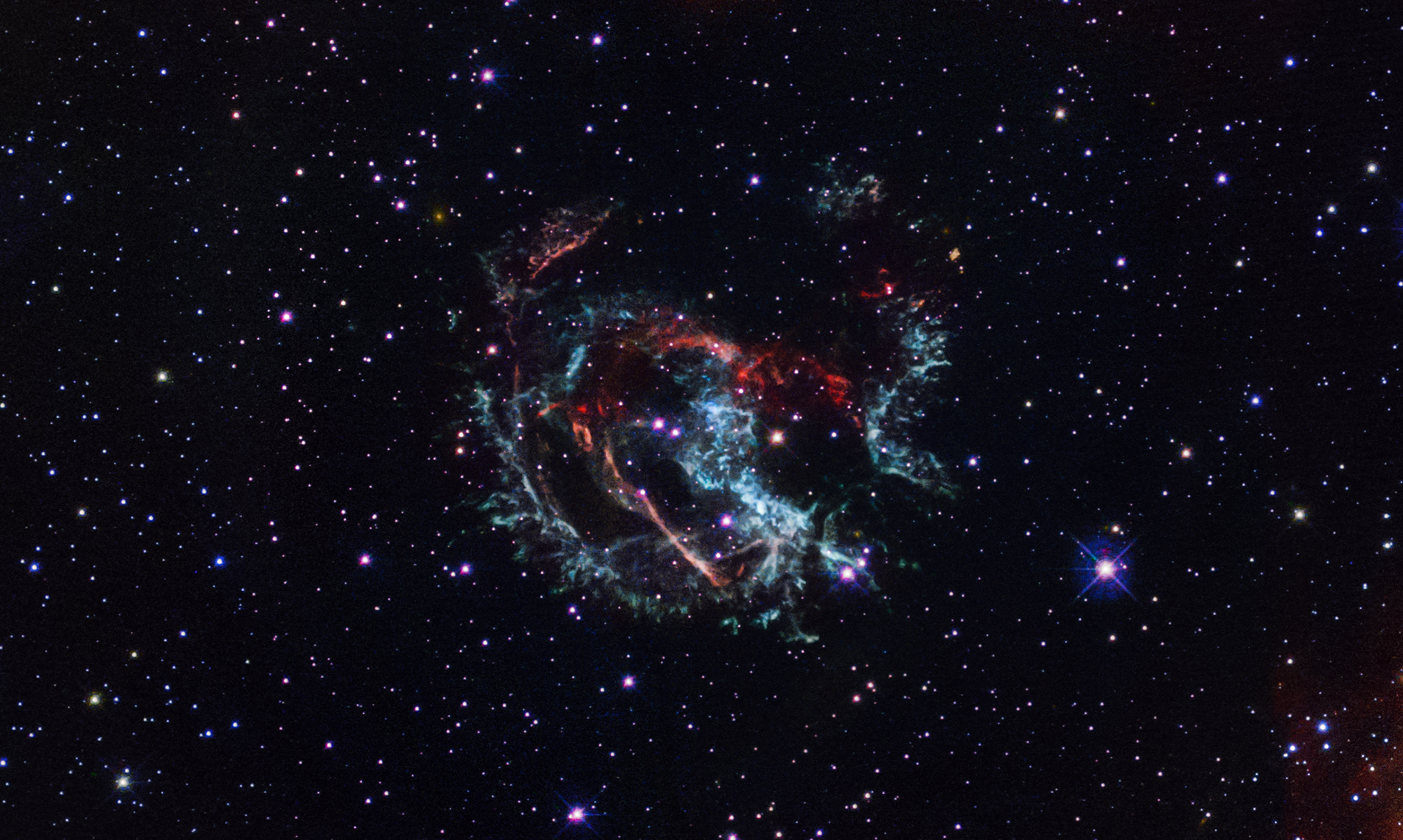Jan 15 2021
Astronomers are turning back the clock on the growing remnants of a neighboring, exploded star.
 The Hubble Space Telescope portrait reveals the gaseous remains of an exploded massive star that erupted approximately 1,700 years ago. The stellar corpse, a supernova remnant named 1E 0102.2-7219, met its demise in the Small Magellanic Cloud, a satellite galaxy of our Milky Way. Image Credit: NASA, ESA, and J. Banovetz and D. Milisavljevic (Purdue University).
The Hubble Space Telescope portrait reveals the gaseous remains of an exploded massive star that erupted approximately 1,700 years ago. The stellar corpse, a supernova remnant named 1E 0102.2-7219, met its demise in the Small Magellanic Cloud, a satellite galaxy of our Milky Way. Image Credit: NASA, ESA, and J. Banovetz and D. Milisavljevic (Purdue University).
With the help of NASA’s Hubble Space Telescope, the astronomers re-examined the rapidly moving shrapnel from the explosion to make a more precise estimation of the time and location of the stellar explosion.
The target is a star that busted long ago in a satellite galaxy, called Small Magellanic Cloud, in the Milky Way. This exploded star left behind growing, gaseous remains—a supernova remnant called 1E 0102.2-7219—initially discovered by NASA’s Einstein Observatory in X-rays. Just like detectives, scientists sifted through archival pictures collected by the Hubble Space telescope and looked at the visible-light observations made a decade apart.
Headed by John Banovetz and Danny Milisavljevic from Purdue University in West Lafayette, Indiana, the researchers quantified the velocities of a total of 45 oxygen-rich, tadpole-shaped clumps of ejecta hurled by the supernova blast. Ionized oxygen glows the brightest in visible light, and hence, it is said to be an exceptional tracer.
To precisely calculate the age of explosion, the researchers collected the 22 fastest traveling knots or clumps. They later established that such targets were probably the least to be slowed down as they traveled via the interstellar material.
The researchers subsequently traced the movement of the knots backward until the ejecta eventually coalesced at one point and identified the site of the explosion. Once the researchers identified that, they could estimate the time it took for the speedy knots to pass from the core of the explosion to their present site.
As per the team’s estimate, light from the blast reached the Earth 1,700 years ago at the time of the decline of the Roman Empire. But only inhabitants of the Earth’s southern hemisphere would have visualized the supernova. Familiar records of this enormous event are not available.
The team’s results vary from the earlier observations of the age and the blast site of the supernova. For instance, previous research works arrived at explosion ages of 2,000 and 1,000 years ago. But according to Banovetz and Milisavljevic, their study is more powerful.
A prior study compared images taken years apart with two different cameras on Hubble, the Wide Field Planetary Camera 2 and the Advanced Camera for Surveys (ACS). But our study compares data taken with the same camera, the ACS, making the comparison much more robust; the knots were much easier to track using the same instrument. It’s a testament to the longevity of Hubble that we could do such a clean comparison of images taken 10 years apart.
Danny Milisavljevic, Study Lead, Purdue University
To study this further, the astronomers also leveraged the sharp images of ACS in choosing the types of ejecta that clumps. In previous studies, scientists calculated explosion age by averaging the speed of all of the gaseous remnants.
But the ACS data showed areas in which the ejecta slowed down because it was bombarding into thicker material shed by the star before it busted as a supernova.
Investigators did consider those knots in the sample. They required the ejecta that optimally reflected their original velocities from the explosion, using them to establish a precise age estimate of the supernova blast.
The Hubble space telescope also clocked the pace of the so-called neutron star—the crushed center of the doomed star—that was hurled from the blast. Based on their estimates, the neutron star should be traveling at over two million miles every hour from the core of the explosion to have reached its present position.
The team identified the suspected neutron star with the European Southern Observatory’s Very Large Telescope based in Chile, along with information from NASA’s Chandra X-ray Observatory.
That is pretty fast and at the extreme end of how fast we think a neutron star can be moving, even if it got a kick from the supernova explosion. More recent investigations call into question whether the object is actually the surviving neutron star of the supernova explosion. It is potentially just a compact clump of supernova ejecta that has been lit up, and our results generally support this conclusion.
John Banovetz, Study Lead, Purdue University
Therefore, the quest may continue for the neutron star.
Our study doesn’t solve the mystery, but it gives an estimate of the velocity for the candidate neutron star.
John Banovetz, Study Lead, Purdue University
Banovetz will present the findings of the study at the American Astronomical Society’s winter meeting on January 14th, 2021.
Hubble Time-Lapse Video Reveals Supernova Remnant Expansion
The time-lapse video shows the movement of a supernova remnant—the gaseous remains of an exploded star—that erupted approximately 1,700 years ago. The stellar corpse, a supernova remnant named 1E 0102.2-7219, met its demise in the Small Magellanic Cloud, a satellite galaxy of our Milky Way. The movie’s opening frame shows ribbons of glowing gaseous clumps that make up the remnant. The video then toggles between two black-and-white images of the remnant, taken 10 years apart, revealing subtle shifts in the ejecta’s expansion over time. Video Credit: NASA, ESA, A. Pagan (STScI), J. Banovetz and D. Milisavljevic (Purdue University).